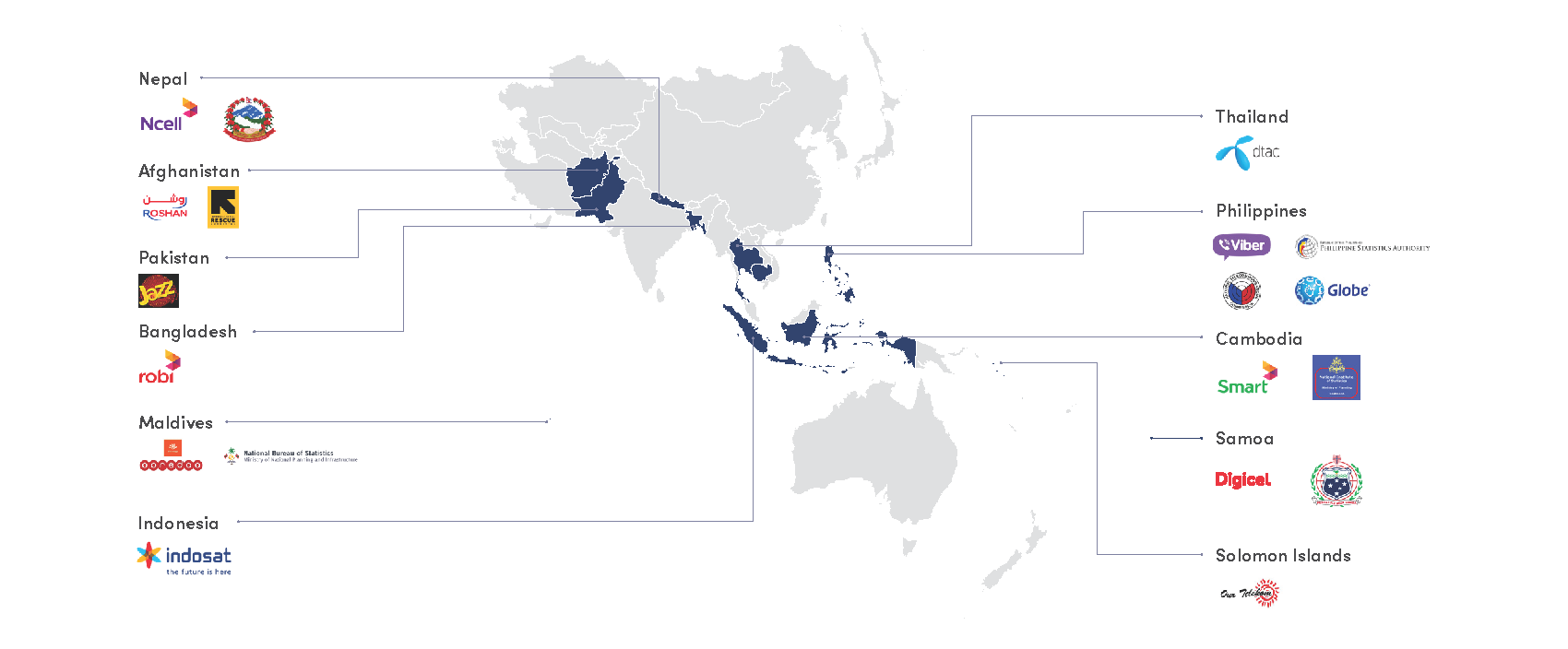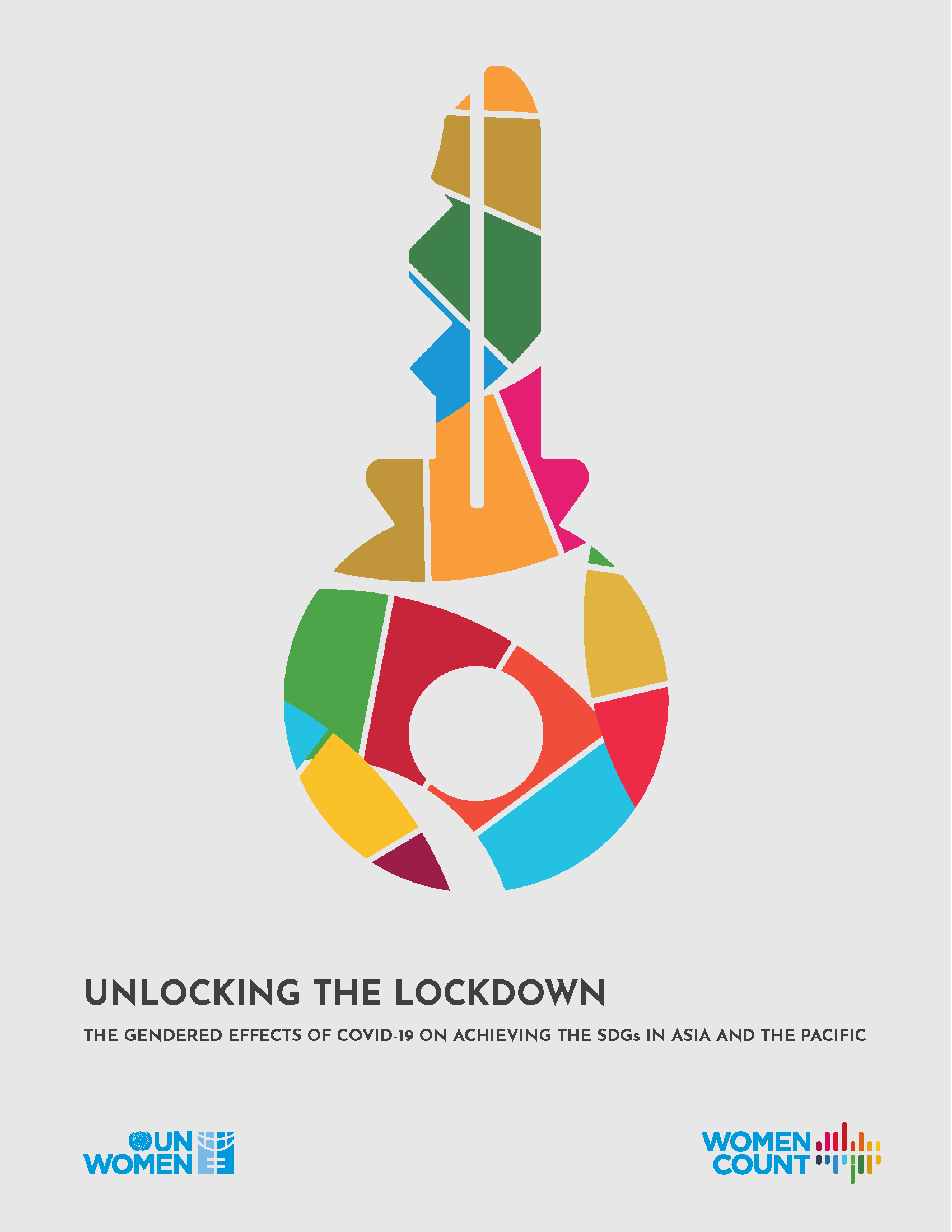
COVID-19 has affected men and women differently. Although more men have died from the pandemic, women’s mental health is taking a bigger toll, their workload at home has multiplied and their economic resources are dwindling.
These effects are hard to capture, as social distancing measures have rendered traditional data collection methods impossible. In response to this challenge, UN Women’s Regional Office for Asia and Pacific turned to innovative solutions to pursue data collection at this critical time.
UN Women engaged with national governments and mobile network operators to roll out a series of rapid assessment surveys in 11 Asia-Pacific countries. As data collection began within a week of the pandemic being declared, results are now available to guide policy makers in their responses.
As a result of COVID-19, women’s economic resources are being hit hardest
COVID-19 is not only a global health crisis. It is also triggering a profound economic recession, which may overturn the gains on poverty reduction that the Asia-Pacific region worked so hard to achieve in the past decades. Data shows that both women and men are experiencing downward changes in the availability of economic resources, but not equally. Most sources of income have decreased for at least 50 per cent of the population. The gender gaps in income reductions are largest in family businesses, remittances, properties and savings, with women at a disadvantage.
Since the outbreak, some people are turning to civil society and government for financial support. More men are accessing these resources than women in most countries, although many people are also finding reductions on the amount of these resources they receive.
Proportion of people who saw decreases in resources since the spread of COVID-19, by sex and type of resources (percentage)
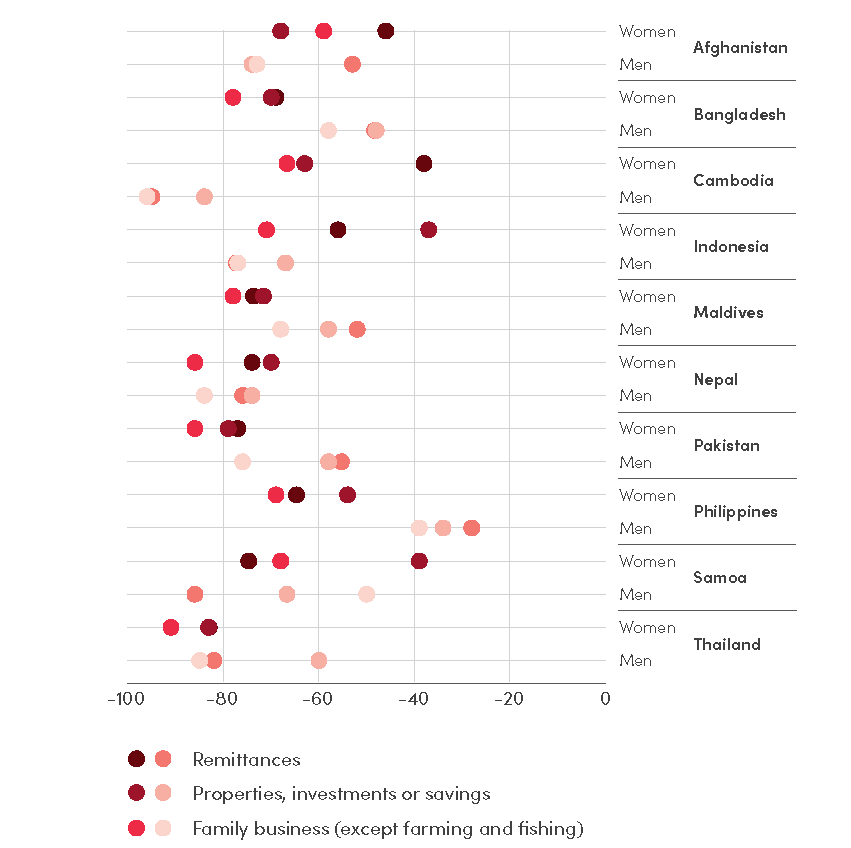
Source: UN Women (2020) Rapid Assessment Surveys on the Consequences of COVID-19 in Asia and the Pacific. Graphs refer to resource users only, not the overall population.
The pandemic is putting food security at risk, as both purchasing and producing food have become harder
Food insecurity may be deepening as a result of COVID-19. Since the pandemic was declared, households noted decreases in food from subsistence farming. Men in South-East Asia and the Pacific noted larger drops than women, while women were more affected in several countries in Southern Asia. Furthermore, an estimated 66 per cent of women and 57 per cent of men in Asia and the Pacific noted decreases in income from farming and fishing, which may translate into food shortages in poorer households.
Barriers to accessing food, hygiene and medical products have grown as a result of movement restrictions and border closures. Overall, 55 per cent of women and 53 per cent of men faced related challenges during lockdowns. In Afghanistan, Bangladesh, Maldives, Nepal, Philippines and Thailand more women than men are finding it difficult to access necessary products.
Proportion of people who noted decreases in income from farming and fishing since the spread of COVID-19, by sex (percentage)
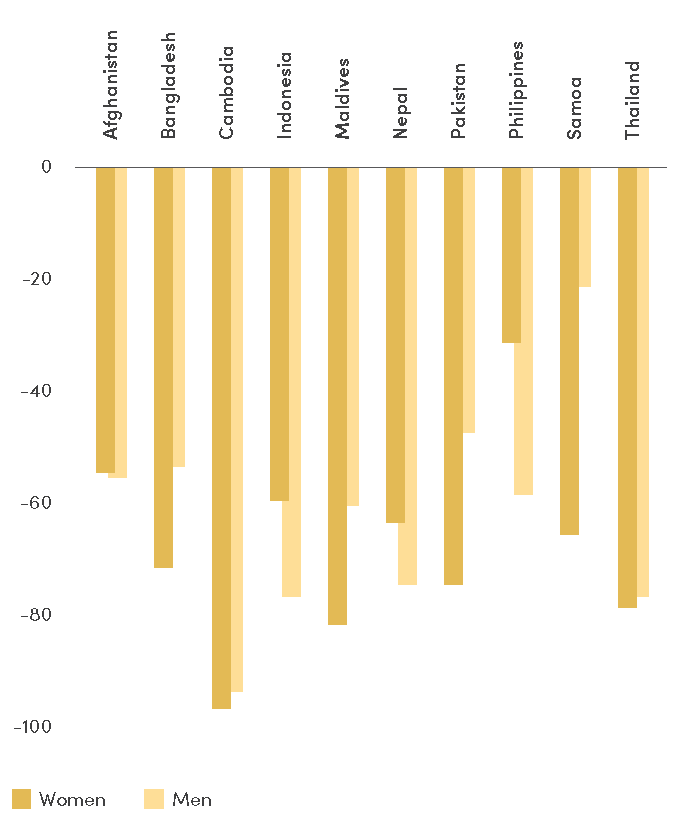
Source: UN Women (2020) Rapid Assessment Surveys on the Consequences of COVID-19 in Asia and the Pacific. Graphs refer to resource users only, not the overall population.
The crisis has disproportionately affected women’s mental and emotional health
Although existing health data shows that men are more likely to die from the COVID-19 virus, the emotional impact of the pandemic is disproportionately falling on women’s shoulders in most countries. Increases in unpaid care and domestic work, job and income loss, and the effects of the lockdown on gender-based violence are among the factors that may be contributing to higher rates of stress and anxiety among women. Younger women and girls (age 10–24 years), in particular, have seen their mental health disproportionately affected.
Proportion of people whose mental and physical health were affected since the spread of COVID-19, by sex (percentage)

Source: UN Women (2020) Rapid Assessment Surveys on the Consequences of COVID-19 in Asia and the Pacific.
School closures prompted parents to take on more teaching duties, including about ways to prevent infection
School closures are key preventive measures to curb the spread of COVID-19. Almost everyone surveyed noted that children’s school was cancelled or the school hours were reduced. To fill the gaps, parents have stepped up with teaching, instructing and training children. An estimated 59 per cent of women and 53 per cent of men reported spending more time on these tasks. In Cambodia, Maldives and Pakistan, female single parents are feeling the burden the most. For many, these responsibilities have to be juggled with household chores and paid work. Along with supporting their children’s schooling, women also play an important role in the promotion of hygiene routines within the household. Their access to reliable sources of COVID-19 information is therefore essential. In more countries, however, more men found the information they received was clear and helpful to prepare for the pandemic.
Proportion of people who found the information on COVID-19 clear and helpful to prepare for the pandemic, by sex (percentage)
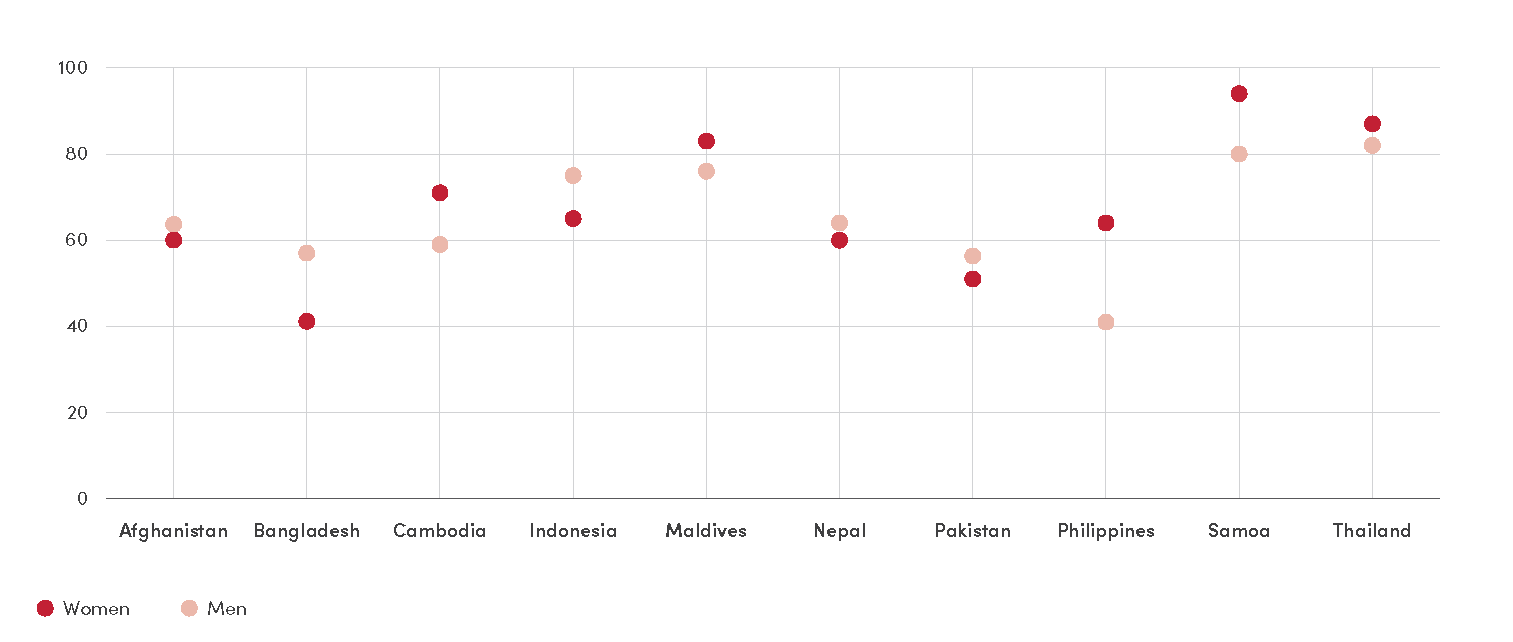
Source: UN Women (2020) Rapid Assessment Surveys on the Consequences of COVID-19 in Asia and the Pacific.
COVID-19 has increased the unpaid care and domestic workload, and women are bearing the heaviest burden
In contrast with previous humanitarian crises, COVID-19 underscores unpaid care as a key dimension of emergency response – it is an enabler of both well-being and income-generation, given the school closures, elder vulnerability and work-from-home arrangements. Lockdowns are also multiplying the domestic workload, another form of essential work, particularly since cleaning can prevent infection. As a result, many women and men worldwide have become teachers, nurses and cooks with a multiplied workload that cannot be outsourced without the risk of bringing infection into the home. Although both women and men are shouldering some of these time burdens, 63 per cent of women and 59 per cent of men have seen increases in unpaid domestic work, and 60 per cent of women and 54 per cent of men saw them in unpaid care work since the spread of COVID-19. This is on top of evidence showing that in the Asia-Pacific region, women were already spending four times as much time as men on unpaid care work prior to the crisis.
Since the spread of COVID-19, 30 per cent of women and 20 per cent of men also experienced increases in the intensity of unpaid domestic and care work (as measured by performing at least three domestic or care work activities). Single women (identified as unmarried/widowed/divorced females) living in households with children, have noted the greatest increases.
Proportion of people whose time allocated to unpaid domestic and care work increased since the spread of COVID-19, by sex and number of activities (percentage)
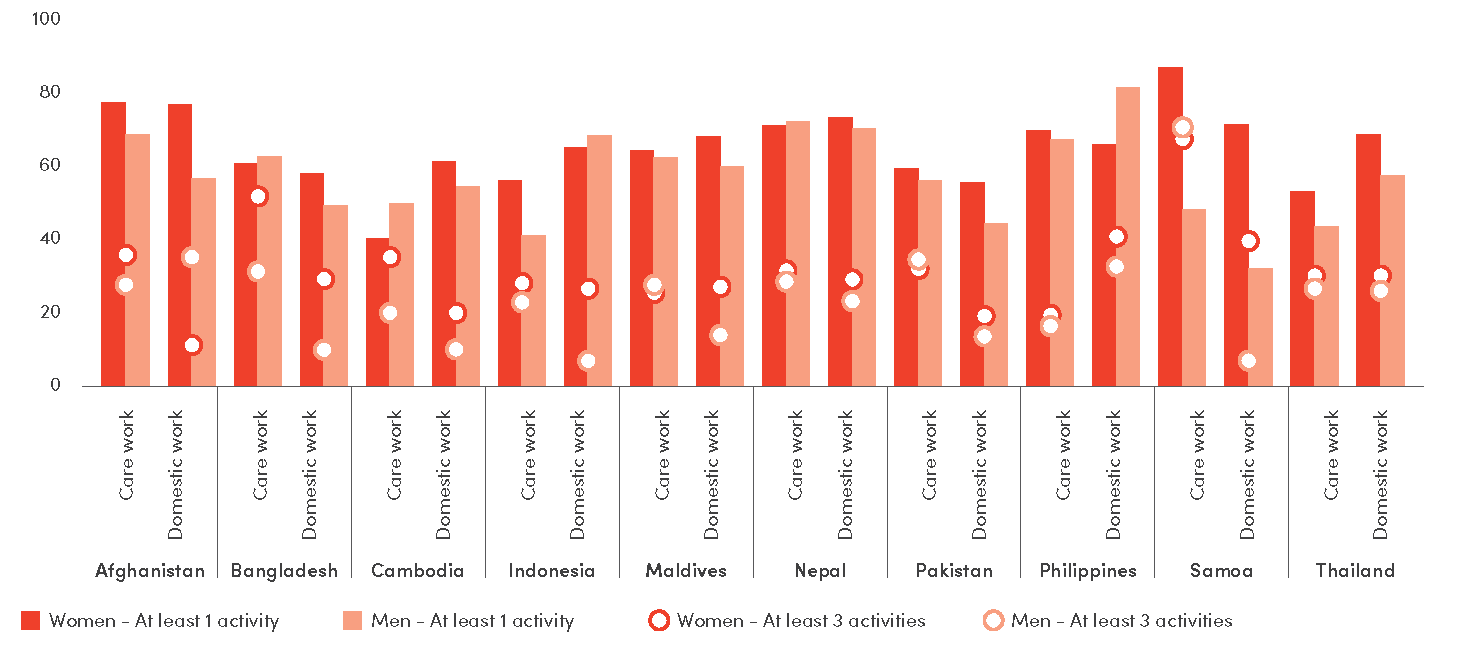
Source: UN Women (2020) Rapid Assessment Surveys on the Consequences of COVID-19 in Asia and the Pacific.
Compromised water sources and social distancing measures have lengthened women’s water and fuel collection times
Washing and sanitizing hands is one of the most effective ways to slow down transmission of COVID-19. However, 34 per cent of people in Asia lack basic handwashing facilities at home and 7 per cent lack access to basic drinking water services. In the Pacific, this share goes up to 13 per cent.
Recent health concerns and social distancing measures compromised the water sources of roughly 23 per cent of people across the region. Besides the medical risks associated with drinking water from a compromised source, the consequences of COVID-19 include lengthened water fetching times for both women and men.
In most countries, more women than men have seen increases in the time they spend on water and firewood collection since the pandemic was declared. This has both physical and mental health consequences, as longer collection times increase the risk of exposure to COVID-19 while reducing the time available for paid work, education or leisure.
Proportion of people whose time spent collecting firewood and fetching water increased since the spread of COVID-19, by sex (percentage)

Source: UN Women (2020) Rapid Assessment Surveys on the Consequences of COVID-19 in Asia and the Pacific. Data refers to the proportion of people who fetch water and/or firewood, not the total population.
Women’s pay has fallen as formal workers see their hours reduced and informal workers lose their jobs
The COVID-19 pandemic is rapidly turning into a profound economic crisis, affecting people’s livelihoods and participation in the labour market. In the Asia-Pacific region, where most of the working population is engaged in informal employment, vulnerability is exacerbated by the lack of social protection. Among informal workers, more men than women have lost their jobs. An estimated 83 per cent of people who lost their jobs or did not work do not receive unemployment benefits or other forms of government support. In the case of women, this figure stands at 84 per cent.
Since the pandemic began, a larger share of women (50 per cent, compared to 35 per cent of men) in formal employment has seen their paid work hours reduced. Also, in most countries it is women overall who are noting the largest drops in income from paid jobs, regardless of whether they engage in formal or informal employment (65 per cent of women and 56 per cent of men noted such decrease). These job and income losses are occurring in labour markets already segregated along gender lines, where women usually earn less than their partners. While only 19 per cent of employed men across the region earned less than their partners prior to the crisis, 53 per cent of employed women did, with the gaps expected to broaden as a result of the economic downturn.
Proportion of employed population who experienced decreases in working time or job losses since the spread of COVID-19, by sex (percentage)

Source: UN Women (2020) Rapid Assessment Surveys on the Consequences of COVID-19 in Asia and the Pacific.
Social distancing measures reduced women’s access to public transit, but technology could help them cope with the challenges
Technology and infrastructure are enablers of resilience to cope with shocks, as they facilitate access to information, employment, mobility and financing. With lockdowns and social distancing measures in place, public transit was interrupted in countries across the region, limiting many women’s mobility as they are less likely than men to own a vehicle. Roughly 65 per cent of people lost access to public transit, with more women than men noting losses in Bangladesh, Cambodia, Nepal, Philippines, Solomon Islands and Thailand. In addition, lockdown regulations in several countries explicitly restricted mobility, requiring permits to justify outings. In the Philippines, for instance, most grocery shopping permits were granted to men, leaving women at home and limiting their agency and access to goods.
Proportion of people who lost access to public transit since the spread of COVID-19, by sex (percentage)
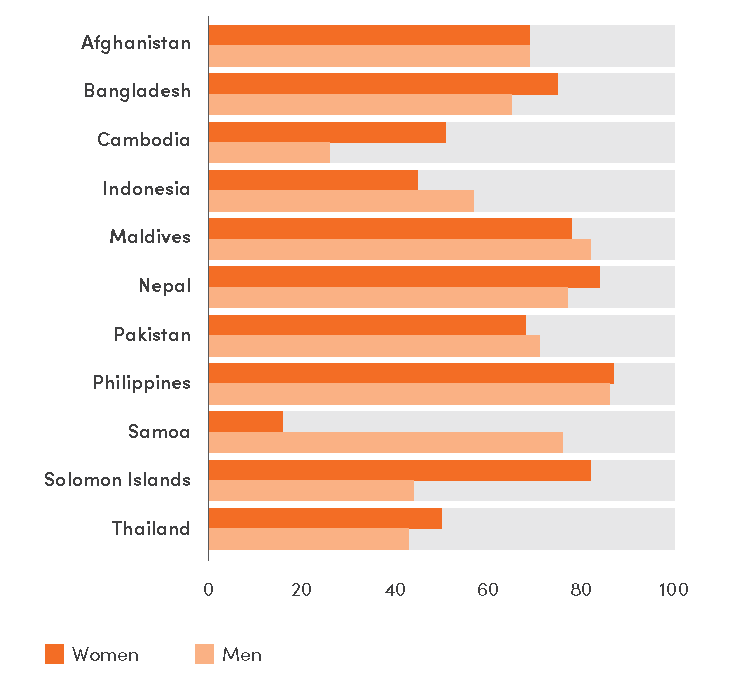
Source: UN Women (2020) Rapid Assessment Surveys on the Consequences of COVID-19 in Asia and the Pacific.
COVID-19 prompted new migration flows and highlighted the challenges that women migrants face
Migrant workers are among the most vulnerable to the consequences of the pandemic. In Thailand, the only country with a large enough sample of migrants in the survey sample, migrants experienced longer wait times to see a doctor and more severe challenges to access hygiene, medical products and food since the spread of COVID-19. Women migrants are particularly disadvantaged regarding access to health care and medical supplies. In the case of mental health, almost all migrant workers have experienced higher levels of stress and anxiety than their non-migrant counterparts.
Proportion of people in Thailand whose mental health was affected, experienced difficulty accessing medical products, and faced longer times to see a doctor, by sex and migratory status (percentage)

Source: UN Women (2020) Rapid Assessment Surveys on the Consequences of COVID-19 in Asia and the Pacific.
Cities provide economic opportunities for women, but COVID-19 poses health hazards for urban residents
Cities offer economic opportunities to women and men. However, their higher population densities pose challenges during health emergencies, particularly for those dwelling in small living spaces and slum settings. Since the spread of COVID-19, residents of large cities are facing significant challenges to perform health routines, an important contributor to overall well-being, physical and emotional health. Women are particularly affected in Bangladesh, Indonesia, Maldives and Nepal. Without routines such as regular exercise and self-care, the mental health of urban dwellers is also taking a toll. Overall, women city residents are seeing their mental health disproportionately affected (70 per cent, compared to 52 per cent men city dwellers).
Proportion of people whose health routines were affected since the spread of COVID-19, by sex and location (percentage)

Source: UN Women (2020) Rapid Assessment Surveys on the Consequences of COVID-19 in Asia and the Pacific.
Note: IP addresses of respondents’ internet connections were used to identify their location (e.g. capital city vs. non-capital city). In all countries, all metropolitan areas of capital cities were considered part of the capital city. In the case of Pakistan, where several other cities are larger than the capital, the “capital city” category includes Islamabad and larger cities. In Afghanistan, due to the widespread use of VPN, the location estimates should be interpreted with caution.
Women are more vulnerable to shocks, especially those in climate-sensitive sectors such as tourism
COVID-19 related travel restrictions have substantially affected the tourism sector globally, where 54 per cent of the workforce is made up of women (compared to 39 per cent of the total workforce). In April 2020 tourism decreased by 98 per cent from the same month the previous year in the Asia-Pacific region. For many economies in the region, especially small island States that depend heavily on tourism, this is having a tremendous impact. Women are not only disproportionately affected, but also at a disadvantage regarding decision-making power for building back better. For recovery efforts to be responsive to women’s needs, they must deliver green jobs, including jobs in sustainable tourism.
Change in international tourism, compared to previous year (percentage)
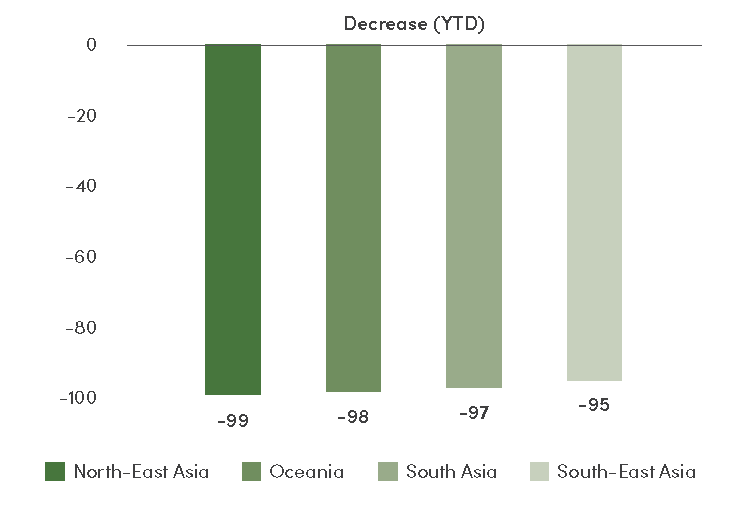
Source: World Tourism Organization. Data refer to April 2020.
The lockdowns jeopardize women’s safety and institutional responses are inadequate
Home is not a safe places for the women and girls who experience violence at the hands of their intimate partners or other family members. As a result of the lockdowns, many of them are confined with their abusers, with limited options for help-seeking in confidence. Civil society organizations (CSOs) who provide services to women victims of violence have seen increases in the number of victims reaching out for help. More than 40 per cent of those CSOs saw increases in cases of violence perpetrated by family members, with violence from employers and other community members being the second and third most common causes of increase.
Given the current social distancing measures, civil society service providers that support victims of violence are finding barriers to business continuity, as many have had to minimize staff presence and cannot fully support survivors due to funding shortages and closing of offices. Nevertheless, most of these organizations continue to operate, particularly to provide referral services, emergency aid and psycho-social services, as well as legal services.
Proportion of organizations who observed changes in violence against women, by perpetrator (percentage)
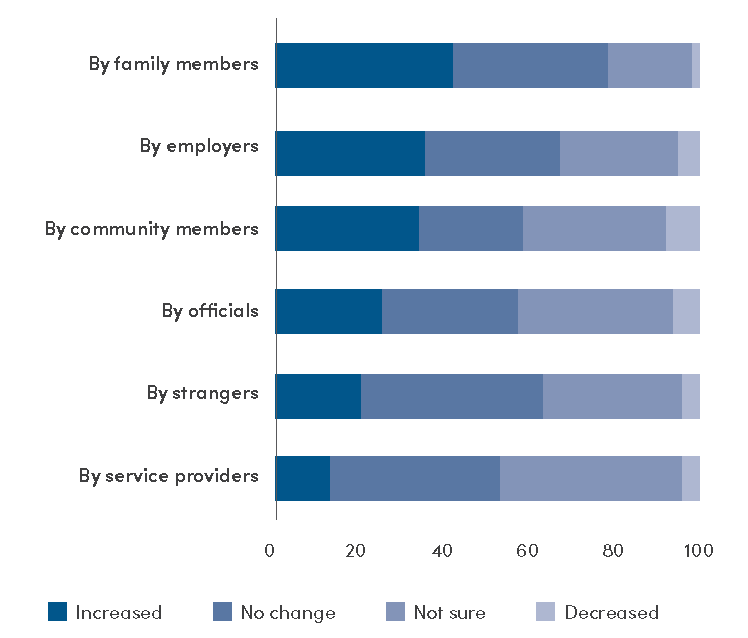
Gender data availability is increasing for SDG indicators, but with COVID-19 innovative approaches are needed
In times of crisis, quality data is essential to inform evidence-based responses that meet the needs of all population groups. However, measures to contain the pandemic have halted face-to-face data collection processes in many countries, impacting the availability and timeliness of data at a time when information could be life-saving.
To fill some of these data gaps, UN Women partnered with mobile network operators and governments across the region to roll out rapid assessment surveys utilizing text messages. This approach enabled swift data collection while complying with social distancing requirements. The public-private partnerships that enabled the survey rollout exemplifies the pivotal role such collaboration can play in achieving the SDGs. Collaboration with public institutions was also critical as it ensured the quality of the data and its responsiveness to national needs.
In select areas of Afghanistan, Samoa and Thailand where social distancing constraints could be mitigated, UN Women complemented telephone-based data collection with face-to-face enumeration, in partnership with other organizations such as the International Rescue Committee. This helped capture key insights about vulnerable groups, such as migrant populations and internally displaced persons.
National statistical offices have also stepped up to generate official estimates to monitor the spread of COVID-19 and its consequences on women’s and men’s lives.
Rollout of UN Women rapid assessment surveys in partnership with the private sector, national Governments and international organizations in Asia-Pacific
